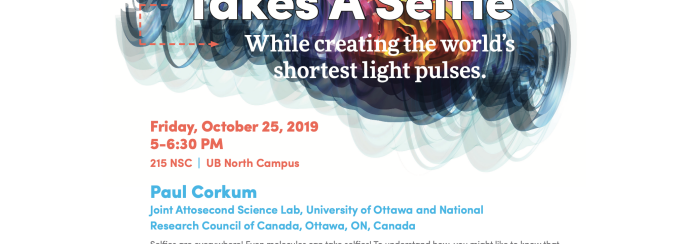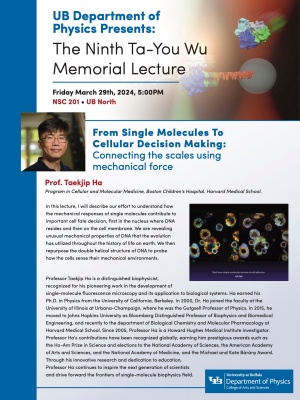Ta-You Wu Lecture Series
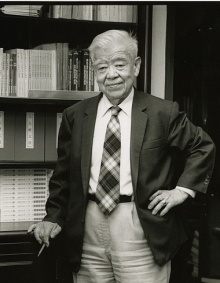
Professor Ta-You Wu
The Ta-You Wu Lecture Series was established through a generous endowment in remembrance of former physics colleague, Professor Ta-You Wu. Professor Wu served as a faculty member from 1966 to 1978, and chairman from 1966 to 1969.
Thenth Ta-You Wu Memorial Lecture
April 18, 2025 , 5:00 PM, NSC 201-UB North Campus
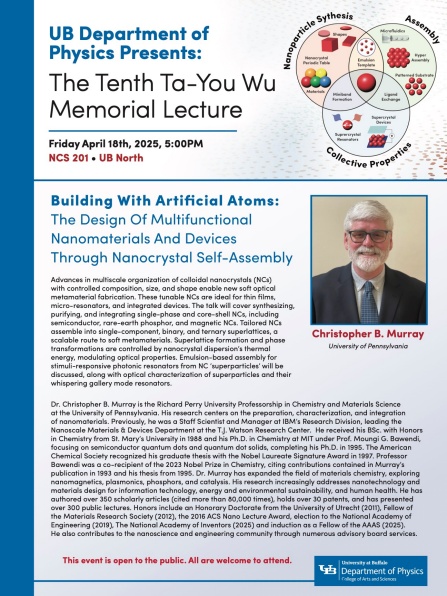
Ta-You Wu, PhD, was born in Canton, China in 1907, a time when the country was experiencing tremendous turmoil. He completed undergraduate study in Nankai University and received his PhD in 1933 from the University of Michigan. Professor Wu returned to China to teach at Peking University, but later moved to Kunming at the outbreak of the second Sino-Japan War. It was during this extremely difficult time (1934-1946) that Professor Wu introduced modern physics to a generation of young physicists in China. Professor Wu's Chinese students include Nobel Laureates C. N. Yang and T. D. Lee. It was also during this time that Professor Wu published his first book, Vibrational Spectra and Structure of Polyatomic Molecules, for which he received the 1939 Ting Memorial Prize of the Academia Sinica.
After the Second World War, Professor Wu returned to the U.S. to continue his research. From 1949 to 1963, Professor Wu directed the Theoretical Physics Division of the National Research Council of Canada, then joined the UB Department of Physics in 1966. He was a physics faculty member from 1966 to 1978, serving as chairman from 1966 to 1969.
Professor Wu was one of the leading atomic and nuclear physicists of his generation. He authored 20 books and published over 120 papers on a wide range of topics. Sometimes referred to as the "Father of Chinese Physics," Professor Wu was a renowned educator who inspired generations of physics students. He also made significant contributions to the science and technology development in Taiwan.
Professor Wu was appointed Director of the Institute of Physics of Academia Sinica in 1962, Chairman of the National Science Council of the Republic of China in 1967, and Chair of the Committee for Science Development of the National Security Council, Republic of China, in 1967. He was President of Academia Sinica from 1983 to 1994.
The endowment for the Wu Lectureship was established by Professor Y. C. Lee, a long-time colleague and close friend of Professor Wu, and has received contributions from over 70 donors. These donors wish to remember Professor Wu's long-lasting influence on their scientific and personal lives, as well as promote academic excellence and education in physics.
Past Lectures
Condensed Matter Physics: The Goldilocks Science

Presented by Professor Marvin L. Cohen, UC Berkeley
I have the privilege of telling you about some of the achievements and research in Condensed Matter Physics (CMP), also known as Solid State Physics. Since the focus in CMP is on energies, sizes, and time scales that are not extremely big or extremely small, but somewhere we loosely call the "middle," it is an area of science that reminds us of Goldilocks who said, "Ahhh, this porridge is just right," and she happily ate it all up. It can be argued that because of its "Goldilocks nature," CMP has many links to other branches of physics and more generally other areas of science and engineering. These collaborations with fields like electrical engineering, computer science, material science, medical science, and chemistry have led to applications that have had an extremely large influence on our everyday life. The transistor, solar battery, MRI, and other solid-state devices such as lasers, are a few of the many applications associated with this field. So it can be said that physics is the central science, and CMP, which is the largest branch of physics, is in the center of physics.
CMP is very broad and has both an applied and a fundamental physics component. I will focus mainly on the latter with emphasis on this field's intellectual and conceptual contributions to science. I plan to describe some of the fascinating research involving semiconductors, superconductors, and nanoscience. I'll begin by telling of the development of these areas over the past hundred years, and then I'll discuss some current achievements and discoveries with some focus on contributions from individuals in our own Physics Department. I'll also relay a few observations about Einstein and his seminal research in CMP. However I should add that Einstein suggested that we might never have a theoretical explanation of superconductivity, but Einstein was not always right.
–Professor Marvin L. Cohen
About the Speaker: Marvin L. Cohen joined the Berkeley Physics Faculty in 1964, and became University Professor in 1995. He has also been a Senior Faculty Scientist at the Lawrence Berkeley National Laboratory since 1965. Professor Cohen's research covers a broad spectrum of subjects in theoretical condensed matter physics. He is best known for his work with pseudopotentials with applications to electronic, optical, and structural properties of materials, superconductivity, semiconductor physics, and nanoscience. Professor Cohen has published about 800 papers and is currently ranked number two among the most cited physicists with an h-index of 102.
Professor Cohen is a Fellow of the American Physical Society, a member of the National Academy of Sciences, the American Academy of Arts and Sciences, the American Philosophical Society, and a Fellow of the American Association for the Advancement of Science.
Professor Cohen is a recipient of the National Medal of Science, the APS Oliver E. Buckley Prize for Solid State Physics, the APS Julius Edgar Lilienfeld Prize, the Foresight Institute Richard P. Feynman Prize in Nanotechnology, the Technology Pioneer Award from the World Economic Forum, and the Dickson Prize in Science. Professor Cohen was President of the American Physical Society (APS) (2005). He has served as a member and then chair of the Executive Council of the Division of Condensed Matter Physics of the APS; U.S. representative on the IUPAP Semiconductor Commission; a member of the National Academy of Sciences Government-University Industry Research Roundtable; Member, U.S. Delegation to Bilateral Dialog for Research and Development in the US and Japan; Member, Science Policy Board of the Stanford Synchrotron Radiation Laboratory and the Science Policy Committee of SLAC. He was a Member of the Governing Board of the American Institute of Physics.
Quarks and cold atoms: From the hottest to the coldest places in the Universe

Presented by Professor Gordon Baym, University of Illinois at Urbana-Champaign
Abstract: In recent years physicists have created several new forms of matter -- the densest hottest matter in the universe called a "quark-gluon plasma", and the coldest matter in the universe, in the form of trapped atomic gases. This talk will describe these two exciting forms of matter and touch upon unexpected connections between them.
About the Speaker: Professor Baym received his bachelor's degree in physics from Cornell University in 1956, his AM in mathematics from Harvard in 1957, and his PhD in physics from Harvard in 1960. He joined the Department of Physics at the University of Illinois as an assistant professor in 1963. Professor Baym has been a major leader in the study of matter under extreme conditions in astrophysics and nuclear physics. He has made original, seminal contributions to our understanding of neutron stars, relativistic effects in nuclear physics, condensed matter physics, quantum fluids, and most recently, Bose-Einstein condensates. His work is characterized by a superb melding of basic theoretical physics concepts, from condensed matter to nuclear to elementary particle physics.
Professor Baym is a member of the National Academy of Sciences (where he served as Chair of the Physics Section) and a member of the American Philosophical Society. He was awarded the Hans A. Bethe Prize of the American Physical Society in 2002 "for his superb synthesis of fundamental concepts which have provided an understanding of matter at extreme conditions, ranging from crusts and interiors of neutron stars to matter at ultrahigh temperature."
The Coolest Use of Light: How to Make the Coolest Matter in the Universe
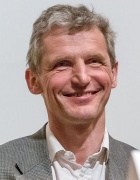
Presented by Nobel Laureate Professor Wolfgang Ketterle, Massachusetts Institute of Technology
Abstract: Light has many important properties and applications. I will explain that light exerts forces on particles and objects. These forces deflect the tails of comets, they are used in the form of optical tweezers to manipulate cells and DNA in biological samples, and they allow the trapping of atoms. These forces are microscopically explained by the momentum of the photon, the quantum of light. Photons also have energy which can be used to heat pellets to temperatures comparable to those inside the sun and enable nuclear fusion. However, laser light can also cool matter to temperatures close to absolute zero. In this regime, new materials with novel properties are observed.
About the Speaker: Professor Wolfgang Ketterle, PhD, is the John D. MacArthor Professor of Physics at the Massachusetts Institute of Technology. He received his PhD from Max Planck Institute in 1986, and joined MIT in 1990. His group was the first in the world to achieve Bose-Einstein condensation in a dilute gas of sodium atoms. Over the next few years, his group demonstrated matter wave interference and atom lasing, among other impressive experiments showing the effect of quantum coherence of a large group of cold atoms. In 2001 Professor Ketterle, together with Eric Cornell and Carl Wieman from JILA Colorado, won the Nobel Prize in Physics "for the achievement of Bose-Einstein condensation in dilute gases of alkali atoms, and for early fundamental studies of the properties of the condensates." More recently, his group has explored superfluidity of fermions (the BEC-BCS crossover), and realized synthetic magnetic fields for neutral atoms.
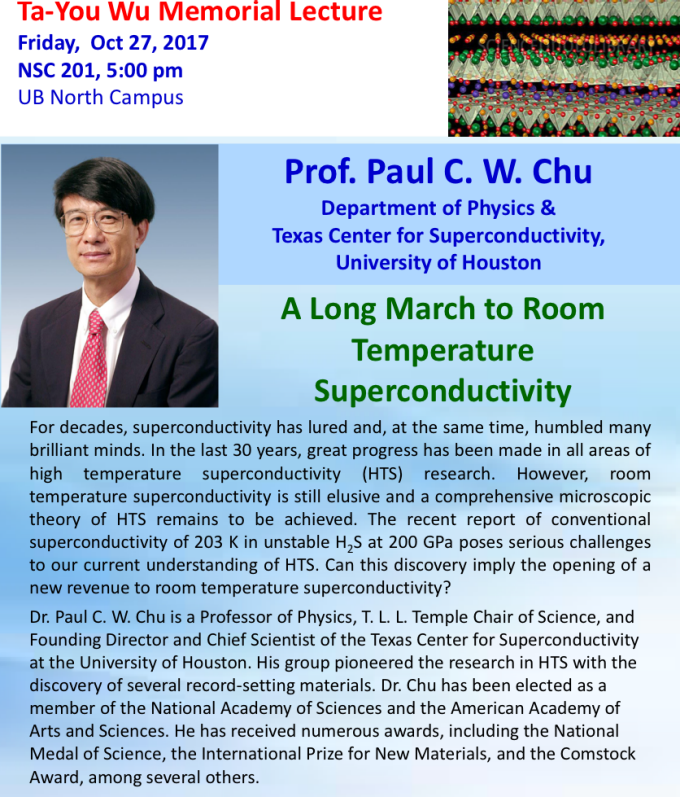
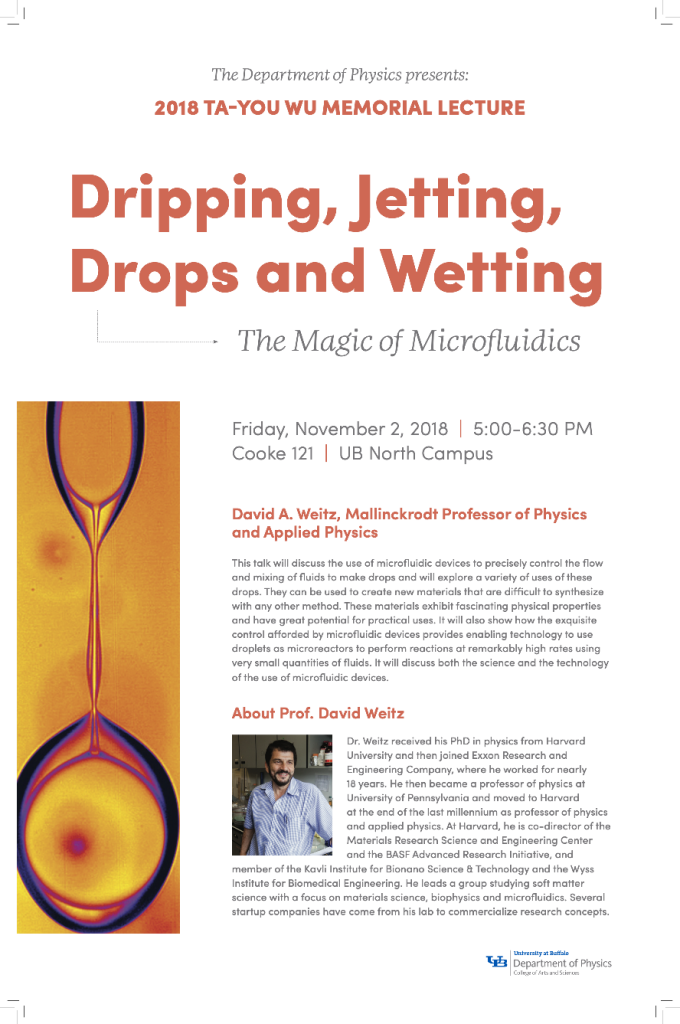
Remembering Professor Wu
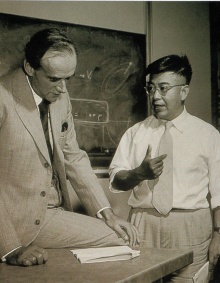
Professor Wu and Dr. Paul Dirac
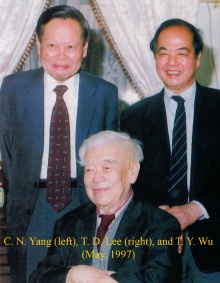
Professor Wu with former students Dr. C. N. Yang and Dr. T. D. Lee

Front: Dr. Shiing-Shen Chern (left), Professor Wu (middle), Dr. Ta-Jen Wu (right)
Back: Dr. Guo-Guang Mu (left) and Dr. C. N. Yang (right)

Professor Wu with former President G. H. W. Bush and former First Lady Barbara Bush
